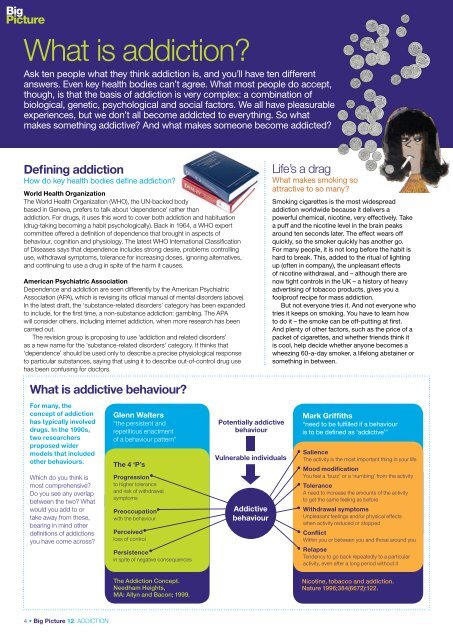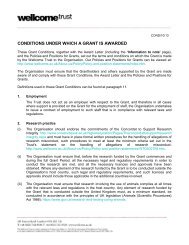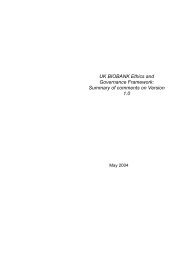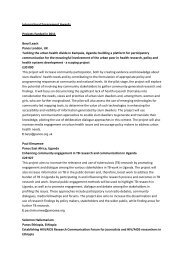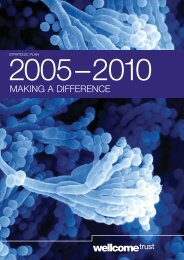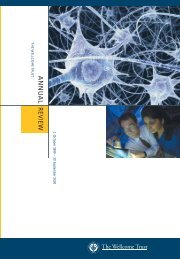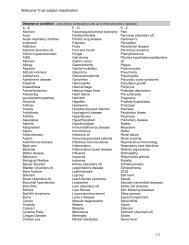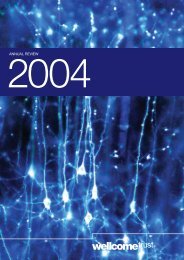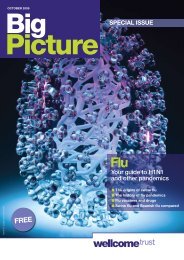Big Picture: Addiction - Wellcome Trust
Big Picture: Addiction - Wellcome Trust
Big Picture: Addiction - Wellcome Trust
You also want an ePaper? Increase the reach of your titles
YUMPU automatically turns print PDFs into web optimized ePapers that Google loves.
<strong>Picture</strong><br />
<strong>Big</strong><br />
What is addiction<br />
Ask ten people what they think addiction is, and you’ll have ten different<br />
answers. Even key health bodies can’t agree. What most people do accept,<br />
though, is that the basis of addiction is very complex: a combination of<br />
biological, genetic, psychological and social factors. We all have pleasurable<br />
experiences, but we don’t all become addicted to everything. So what<br />
makes something addictive And what makes someone become addicted<br />
Defining addiction<br />
How do key health bodies define addiction<br />
World Health Organization<br />
The World Health Organization (WHO), the UN-backed body<br />
based in Geneva, prefers to talk about ‘dependence’ rather than<br />
addiction. For drugs, it uses this word to cover both addiction and habituation<br />
(drug-taking becoming a habit psychologically). Back in 1964, a WHO expert<br />
committee offered a definition of dependence that brought in aspects of<br />
behaviour, cognition and physiology. The latest WHO International Classification<br />
of Diseases says that dependence includes strong desire, problems controlling<br />
use, withdrawal symptoms, tolerance for increasing doses, ignoring alternatives,<br />
and continuing to use a drug in spite of the harm it causes.<br />
American Psychiatric Association<br />
Dependence and addiction are seen differently by the American Psychiatric<br />
Association (APA), which is revising its official manual of mental disorders (above).<br />
In the latest draft, the ‘substance-related disorders’ category has been expanded<br />
to include, for the first time, a non-substance addiction: gambling. The APA<br />
will consider others, including internet addiction, when more research has been<br />
carried out.<br />
The revision group is proposing to use ‘addiction and related disorders’<br />
as a new name for the ‘substance-related disorders’ category. It thinks that<br />
‘dependence’ should be used only to describe a precise physiological response<br />
to particular substances, saying that using it to describe out-of-control drug use<br />
has been confusing for doctors.<br />
Life’s a drag<br />
What makes smoking so<br />
attractive to so many<br />
Smoking cigarettes is the most widespread<br />
addiction worldwide because it delivers a<br />
powerful chemical, nicotine, very effectively. Take<br />
a puff and the nicotine level in the brain peaks<br />
around ten seconds later. The effect wears off<br />
quickly, so the smoker quickly has another go.<br />
For many people, it is not long before the habit is<br />
hard to break. This, added to the ritual of lighting<br />
up (often in company), the unpleasant effects<br />
of nicotine withdrawal, and – although there are<br />
now tight controls in the UK – a history of heavy<br />
advertising of tobacco products, gives you a<br />
foolproof recipe for mass addiction.<br />
But not everyone tries it. And not everyone who<br />
tries it keeps on smoking. You have to learn how<br />
to do it – the smoke can be off-putting at first.<br />
And plenty of other factors, such as the price of a<br />
packet of cigarettes, and whether friends think it<br />
is cool, help decide whether anyone becomes a<br />
wheezing 60-a-day smoker, a lifelong abstainer or<br />
something in between.<br />
What is addictive behaviour<br />
For many, the<br />
concept of addiction<br />
has typically involved<br />
drugs. In the 1990s,<br />
two researchers<br />
proposed wider<br />
models that included<br />
other behaviours.<br />
Which do you think is<br />
most comprehensive<br />
Do you see any overlap<br />
between the two What<br />
would you add to or<br />
take away from these,<br />
bearing in mind other<br />
definitions of addictions<br />
you have come across<br />
Glenn Walters<br />
“the persistent and<br />
repetitious enactment<br />
of a behaviour pattern”<br />
The 4 ‘P’s<br />
Progression<br />
to higher tolerance<br />
and risk of withdrawal<br />
symptoms<br />
Preoccupation<br />
with the behaviour<br />
Perceived<br />
loss of control<br />
Persistence<br />
in spite of negative consequences<br />
Potentially addictive<br />
behaviour<br />
Vulnerable individuals<br />
Addictive<br />
behaviour<br />
Mark Griffiths<br />
“need to be fulfilled if a behaviour<br />
is to be defined as ‘addictive’”<br />
Salience<br />
The activity is the most important thing in your life<br />
Mood modification<br />
You feel a ‘buzz’ or a ‘numbing’ from the activity<br />
Tolerance<br />
A need to increase the amounts of the activity<br />
to get the same feeling as before<br />
Withdrawal symptoms<br />
Unpleasant feelings and/or physical effects<br />
when activity reduced or stopped<br />
Conflict<br />
Within you or between you and those around you<br />
Relapse<br />
Tendency to go back repeatedly to a particular<br />
activity, even after a long period without it<br />
The <strong>Addiction</strong> Concept.<br />
Needham Heights,<br />
MA: Allyn and Bacon; 1999.<br />
Nicotine, tobacco and addiction.<br />
Nature 1996;384(6672):122.<br />
4 • <strong>Big</strong> <strong>Picture</strong> 12: ADDICTION


